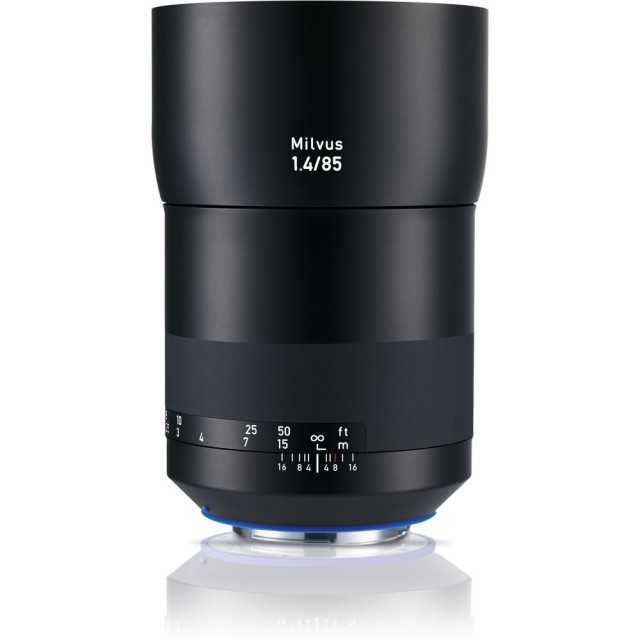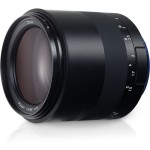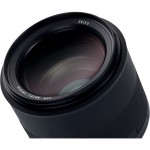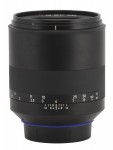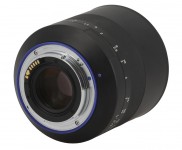Announced
Production status
Original name
Pros and cons
Genres or subjects of photography
Recommended slowest shutter speed when shooting static subjects handheld
ZEISS Milvus Planar T* 85mm F/1.4 ZE / ZF.2
Short telephoto prime lens • Digital era
Abbreviations
| T* | Multi-layer anti-reflection coating is applied to the surfaces of lens elements. This anti-reflection coating increases light transmission, eliminates flare and ghosting, and maintains color consistence among all lens models. |
| ZE | The lens is designed for Canon EOS 35mm SLR cameras but can be also used on APS-C SLR cameras. |
| ZF.2 | The lens is designed for Nikon 35mm SLR cameras but can be also used on APS-C SLR cameras. The lens features a built-in CPU which is used to transfer metering data from the lens to the camera. |
Model history
| ■Carl Zeiss Planar T* 85mm F/1.4 [AE, MM] | A | 6 - 5 | 1.00m | E67 | 1974 ● | |
| ■Carl Zeiss Classic Planar T* 85mm F/1.4 ZE / ZF / ZF.2 / ZK | A | 6 - 5 | 1.00m | E72 | 2006 ● | |
| Carl Zeiss Classic Planar 85mm F/1.4 ZF-IR | 2007 ● | |||||
| ■ZEISS Milvus Planar T* 85mm F/1.4 ZE / ZF.2 | A | 11 - 9 | 0.80m | E77 | 2015 ● | |
Specification



| Optical design: | |
| 85mm | |
| F/1.4 | |
| 35mm full frame | |
| Canon EF [44mm] | |
| Nikon F [46.5mm] | |
| 28.5° (35mm full frame) | |
| 11 elements in 9 groups | |
| 7 AD | |
| Floating element system | |
| On Canon EOS APS-C [1.59x] cameras: | |
35mm equivalent focal length: | 135.2mm (in terms of field of view) |
35mm equivalent speed: | F/2.2 (in terms of depth of field) |
Diagonal angle of view: | 18.2° |
| On Nikon D APS-C [1.53x] cameras: | |
35mm equivalent focal length: | 130.1mm (in terms of field of view) |
35mm equivalent speed: | F/2.1 (in terms of depth of field) |
Diagonal angle of view: | 18.9° |
| Diaphragm mechanism: | |
Diaphragm type: | Automatic |
Aperture control: | None; the aperture is controlled from the camera (Canon EF) |
| Aperture ring (Manual settings + Auto Exposure setting) (Nikon F) | |
| 9 (nine) | |
| Focusing: | |
| 0.8m | |
| 1:8.3 | |
Focusing modes: | Manual focus only |
Manual focus control: | Focusing ring |
| Physical characteristics: | |
| 1280g (Canon EF) | |
| 1210g (Nikon F) | |
| ⌀90×113mm (Canon EF) | |
| ⌀90×110mm (Nikon F) | |
| Dust-proof and water-resistant barrel | |
| - | |
| Accessories: | |
| Screw-type 77mm | |
| 2144-612 - Bayonet-type round | |
| Not available |
Sources of data
- Manufacturer's technical data.
- ZEISS lenses for SLR cameras booklet (PUB. EN_10_025_0020II).
Manufacturer description #1
New ZEISS SLR Lens Family for ZE and ZF.2 Mounts
Six new focal lengths: manual focus lenses optimized for high-resolution cameras
OBERKOCHEN/Germany, 2015-09-10.
The new ZEISS Milvus SLR lens family contains six focal lengths with ZE or ZF.2 mounts for DSLR cameras from Canon and Nikon1. The ZEISS Milvus lens family with precise manual focus offers high and consistent image performance across all focal lengths. The new lenses are the ZEISS answer to the current trend toward sensors with increasingly high resolution which, in turn, require higher and higher image quality. They are therefore ideal for current DSLR cameras and also for mirrorless system cameras of the Sony α7 series via an adapter solution and offer the customer excellent value for the money for professional applications. An equally important benefit: their high contrast rendition and low level of stray light ensure that the lenses meet the latest video standards such as HDR (High Dynamic Range) and resolutions of 6K and more. For the user, they open up the field of professional video and cine applications. The ZEISS Milvus lenses will be delivered to dealers in October 2015.
Diversity of focal lengths for wide spectrum of applications
With its diversity of focal lengths, the ZEISS Milvus lens family covers many of the photographer's important fields of application where the benefits of manual focus lenses can be optimally utilized. "We want to provide users with the freedom to use the focus position as an artistic tool because it is one of the most important creative possibilities available to photographers," Christophe Casenave, Product Manager for ZEISS Camera Lenses, emphasizes. The ZEISS Milvus lenses are therefore targeted at all owners of a high-resolution DSLR camera, offering them considerable added value. They are also suitable for photographers who have specialized in applications which the six focal lengths optimally support, e.g. portrait, landscape and macro photography.
The ZEISS Milvus lens family will initially consist of the following six focal lengths: ZEISS Milvus 2.8/21, ZEISS Milvus 2/35, ZEISS Milvus 1.4/50, ZEISS Milvus 1.4/85 as well as the two macro lenses ZEISS Milvus 2/50M and ZEISS Milvus 2/100M. Further focal lengths will be added to the ZEISS Milvus lens family over the next few years. "With this diversity of extremely high-quality SLR lenses, we are underscoring that, with our Milvus lenses, we can supply the right focal length for almost any application or personal preference," Casenave says.
Modern product design
The ZEISS Milvus lenses continue the award-winning ZEISS product design already featured in the ZEISS Otus lenses. The advanced design ensures excellent image performance and outstanding ergonomic convenience. The easy-grip focus ring enables precise manual focusing for highly precise photography. The robust all-metal barrel of the ZEISS Milvus lenses guarantees many years of reliable use. They are protected against dust and spray water. The robust metal lens shade is an integral part of the overall product design and is a standard feature of all ZEISS Milvus lenses on delivery.
Fully compatible with DSLR cameras
The ZEISS Milvus lenses support all important operating modes of DSLR cameras (e.g. aperture priority, shutter priority and program modes, as well as manual time and exposure settings) The ZEISS Milvus lenses feature an interface that transmits the lens data to the camera (e.g. focal length, set aperture etc.). This information is saved to the photo's EXIF data.
Features for demanding users
"The excellent image performance of the ZEISS Milvus lenses, also in difficult light conditions, is sharply focused on the requirements of current and future high-performance digital cameras," says Casenave. The lenses offer a harmonious bokeh and excellent reflection reduction thanks to T*® anti-reflective coating from ZEISS. The further optimization of the lens coating reduces ghosting, flare and shading effects in critical light situations. All ZEISS Milvus lenses have a Floating Elements Design which compensates for aberrations at different distance settings. This is achieved by varying the axial distance between individual lens elements or groups. The adjustment of the distance between elements is coupled to the distance setting so that this always results in the right correction.
ZEISS Milvus lenses for video
The new ZEISS Milvus lenses enable high-quality film recordings with soft and cinematic bokeh. "With their extremely high contrast rendition, the lenses meet the latest 6K video standards and display uniform color characteristics," Casenave continues. All six ZEISS Milvus lenses have an exceptionally long rotation angles of the focus ring for precise focusing. The practical, rubber-covered focus ring features outstanding grip properties for optimal focusing. The 'de-click' function in the ZF.2 mount lenses allows filmmakers to adjust the aperture freely and smoothly, enabling professional results even in changing light conditions.
ZEISS Milvus 1.4/85
The newly designed ZEISS Milvus 1.4/85 short tele lens has eleven elements in nine groups and features the ZEISS Planar optical design. The ZEISS Milvus 1.4/85 is suitable, above all, for portrait photography. This lens is an absolute must for compositions where the main subject is to be isolated and emphasized against a beautiful bokeh background. The purely spherical optical design generates a harmonious bokeh, and the use of special glass materials ensures extremely low chromatic aberration.
Manufacturer description #2
The subject stands out with astounding clarity against a background that vanishes masterfully in the soft bokeh of the image composition. The highly precise, manual focus of the ZEISS Milvus 1.4/85 lets the observer experience every single detail.
The redesigned ZEISS Milvus 1.4/85 lens is particularly suitable for portrait photography. This lens is an absolute must for compositions where the main subject is to be sharply defined and emphasized against a beautiful bokeh background. The purely spherical optical design and use of special types of glass ensure optimal micro-contrast and extremely low chromatic aberration. The result: outstanding photographs every time – with the champion of bokeh.
ZEISS Milvus series
The Milvus lenses from ZEISS will impress you with their constantly excellent image performance across all focal lengths – regardless of whether they are used for portrait, landscape, event or other types of photography. They are optimized for high-resolution digital SLR cameras.
- Outstanding image performance, practically distortion-free;
- Robust, all-metal barrel;
- Dust-proof and water-resistant construction;
- De-click function (ZF.2) for continuous aperture setting for videography;
- Extremely accurate manual focusing thanks to easy-to-grip focus ring.
Lenses with similar focal length
Sorted by manufacturer name
| ■Nikon F mount (10) | |||||||||
| Cosina Voigtlander Color-Heliar 75mm F/2.5 SL | A | 6 - 5 | 0.70m | ⌀49 | 2001 ● | ||||
| Cosina Voigtlander APO-Skopar 90mm F/2.8 SL II S | A | 7 - 7 | 0.90m | ⌀52 | 2021 ● | ||||
| Nikon AI-S Nikkor 85mm F/2 | A | 5 - 5 | 0.85m | ⌀52 | 1981 ● | ||||
| Nikon AI-S Nikkor 85mm F/1.4 | A | 7 - 5 | 0.85m | ⌀72 | 1981 ● | ||||
| Nikon Nikkor-H[·C] Auto 85mm F/1.8 | A | 6 - 4 | 1.00m | ⌀52 | 1964 ● | ||||
| Nikon Nikkor 85mm F/1.8 | A | 6 - 4 | 0.85m | ⌀52 | 1975 ● | ||||
| Nikon AI Nikkor 85mm F/2 | A | 5 - 5 | 0.85m | ⌀52 | 1977 ● | ||||
| Sankyo Kohki Komura 85mm F/1.4 | P | 7 - 5 | 1.00m | ⌀67 | ● | ||||
| Carl Zeiss Classic Planar T* 85mm F/1.4 ZE / ZF / ZF.2 / ZK | A | 6 - 5 | 1.00m | E72 | 2006 ● | ||||
| ZEISS Otus Apo Planar T* 85mm F/1.4 ZE / ZF.2 | A | 11 - 9 | 0.80m | E86 | 2014 ● | ||||
| ■Canon EF mount (5) | |||||||||
| Samyang 85mm F/1.4 IF Aspherical MC aka Bower 85mm F/1.4 IF Aspherical MC aka Rokinon 85mm F/1.4 IF Aspherical MC aka Vivitar Series 1 85mm F/1.4 IF Aspherical MC aka Walimex Pro 85mm F/1.4 IF Aspherical MC | M | 9 - 7 | 1.00m | ⌀72 | 2008 ● | ||||
| Samyang XP 85mm F/1.2 aka Rokinon SP 85mm F/1.2 | A | 10 - 7 | 0.80m | ⌀86 | 2016 ● | ||||
| Samyang 85mm F/1.4 MK2 aka Rokinon 85mm F/1.4 MK2 | M | 9 - 7 | 1.10m | ⌀72 | 2020 ● | ||||
| Carl Zeiss Classic Planar T* 85mm F/1.4 ZE / ZF / ZF.2 / ZK | A | 6 - 5 | 1.00m | E72 | 2006 ● | ||||
| ZEISS Otus Apo Planar T* 85mm F/1.4 ZE / ZF.2 | A | 11 - 9 | 0.80m | E86 | 2014 ● | ||||
| ■Interchangeable mount (5) | |||||||||
| Sankyo Kohki Komura 85mm F/1.4 [Unidapter] | P | 7 - 5 | 1.00m | ⌀67 | 1965 ● | ||||
| Soligor 85mm F/1.5 (s/n 3xxxxxx) [T] | P | 7 - 5 | 0.90m | ⌀62 | 1966 ● | ||||
| Soligor 85mm F/1.8 (s/n 3xxxxxx) [T] | P | ? - ? | 0.90m | ⌀58 | 1966 ● | ||||
| Spiratone 85mm F/1.7 [YS] | A | ? - ? | 0.90m | ⌀55 | ● | ||||
| Vivitar 85mm F/1.8 [T] | P | 6 - 4 | 1.50m | ⌀55 | ● | ||||
